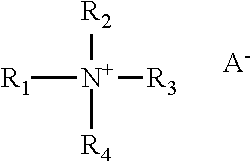Wipe for Use with a Germicidal Solution
a germicidal solution and wipe technology, applied in the direction of biocide, carpet cleaners, disinfectants, etc., can solve the problems of insufficient inhibition of the absorption of quaternary disinfectants on polar materials, the ineffectiveness of antimicrobial agents, and the ineffectiveness of coatings of this nature in killing bacteria on the surfa
- Summary
- Abstract
- Description
- Claims
- Application Information
AI Technical Summary
Benefits of technology
Problems solved by technology
Method used
Image
Examples
example 1
[0062]An uncoated fibrous web was tested for its quaternary amine release properties. The tested fabric was WYPALL®X70, a HYDROKNIT™ material available from Kimberly-Clark® Professional. The web had an average basis weight of 82 grams per meter squared (gsm) and contained pulp fibers hydroentangled into a polypropylene spunbond web having a basis weight of approximately 1 gsm. The quaternary amine was Oasis® 146 from ECOLAB®, Inc., and it was mixed to a 400 ppm of total quaternary amine. Oasis® 146 contains 3% of alkyl C14 50%, C12 40%, C16 10% dimethyl benzyl ammonium chloride, 2.25% of octyl benzyl ammonium chloride, 1.35% didecyl dimethyl ammonium chloride, 0.9% dioctyl dimethyl ammonium chloride, and q.s. water. The fabric was tested using the following procedure:[0063]Mix 1 liter of the Oasis® 146 at 400 ppm in a large one liter beaker.[0064]Collect initial sample of the mixed Oasis® 146 for base line concentration.[0065]Cut 2 to 3 wipes (specimens) to an appropriate size to ac...
example 2
[0099]The WYPALL®X70 sheet of Example 1 was coated with Polymin® SK (BASF) to a target add-on of 0.75% using the following “dip and squeeze” method:[0100]Cut fibrous web samples into desired shape and size, and weigh sample.[0101]Recorded dry sample weight.[0102]Mix treatment bath using distilled and ionized water. Let bath come to room temperature.[0103]Mix bath to a % active concentration to a target wet pick-up and target % by weight add-on.[0104]Dip web / fabric sample into bath and squeeze out excess fluid by running the sample through an Atlas Laboratory Wringer. Alternatively, if the samples are small enough, they could be squeezed by hand.[0105]Weight sample to verify targeted wet pick-up. Wet pick-up=(wet weight−dry weight / wet weight)*100.[0106]If sample is not at target wet pick-up adjust lab wringer pressure or remake treatment bath at new wet pick-up target.[0107]If wet pick-up is correct, hang wet fabric sample in oven and dry for 45 minutes at 90° C.[0108]Let samples reh...
example 3
[0113]A sample was formed as described in Example 2, except that the Polymin® SK had a target add-on level of 1.0% by weight. The Quat Release Value was determined to be 94.5% and the percent reduction of E. coli after 1 minute of exposure was 99.738%.
PUM
| Property | Measurement | Unit |
|---|---|---|
| weight ratio | aaaaa | aaaaa |
| diameter | aaaaa | aaaaa |
| diameters | aaaaa | aaaaa |
Abstract
Description
Claims
Application Information
 Login to View More
Login to View More - R&D
- Intellectual Property
- Life Sciences
- Materials
- Tech Scout
- Unparalleled Data Quality
- Higher Quality Content
- 60% Fewer Hallucinations
Browse by: Latest US Patents, China's latest patents, Technical Efficacy Thesaurus, Application Domain, Technology Topic, Popular Technical Reports.
© 2025 PatSnap. All rights reserved.Legal|Privacy policy|Modern Slavery Act Transparency Statement|Sitemap|About US| Contact US: help@patsnap.com


